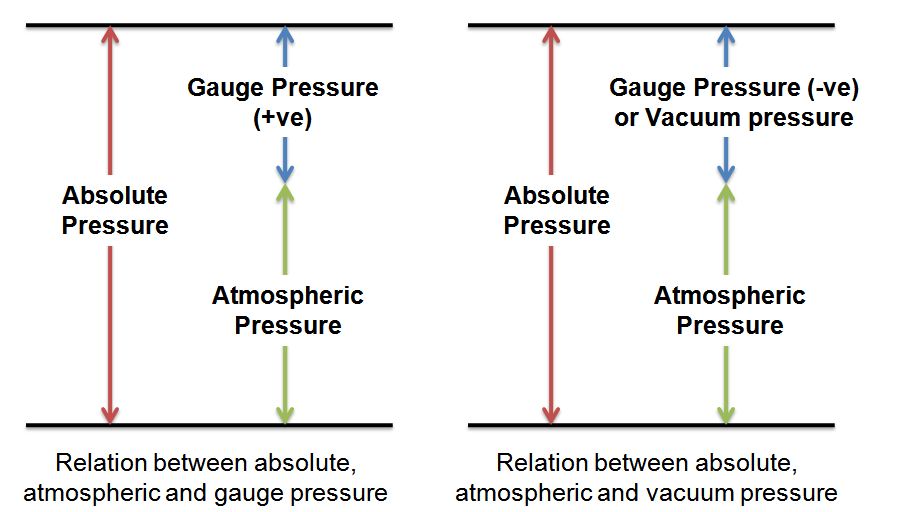Atmospheric pressure: The atmospheric air exerts a normal pressure upon all surfaces with which it is in contact and it is known as atmospheric pressure. Atmospheric pressure is also known as barometric pressure. The atmospheric pressure at sea level (above absolute zero) is called standard atmospheric pressure and its value is given as follows:
Standard atmospheric pressure = 101.3 kN/m2 or kPa (1 kN/m2 = 1 kPa)
= 10.3 m of water
= 760 mm of Hg
Atmospheric pressure = Absolute pressure - Gauge pressure
Gauge Pressure: The pressure measured with the help of a pressure gauge is known as gauge pressure, in which atmospheric pressure is taken as datum. All the pressure gauges record the difference between the actual pressure and the atmospheric pressure. The actual pressure is known as absolute pressure. Mathematically
Absolute pressure= Atmospheric pressure + Gauge pressure (Positive)
Vacuum pressure: For pressures below atmospheric, the gauge pressure will be negative. This negative gauge pressure is known as vacuum pressure. Therefore
Absolute pressure = Atmospheric pressure - Negative gauge pressure or vacuum pressure
153) Gauge pressure at a point is equal to the absolute pressure __________ the atmospheric pressure.
Answer is:
minus
Explanation:

Related Hydraulics and fluid mechanics MCQ with Answers
Answer is:
gauge pressure
Answer is:
pressure head
Answer is:
the liquid particles at different sections have different velocities
Answer is:
Reynold's number
Explanation:
The important dimensionless numbers in fluid mechanics are
1. Reynold’s number
2. Froude’s number
3. Weber’s number
4. Euler’s number
5. Mach’s number or Cauchy’s number
Reynold’s number: Reynold’s number is the ratio of inertia force to the viscous force.
Froude’s number: Froude’s number is the ratio of inertia force to the gravity force.
Weber’s number: Weber’s number is the ratio of inertia force to the surface tension force.
Euler’s number: Euler’s number is the ratio of inertia force to the pressure force.
Mach’s number or Cauchy’s number: Mach’s number or Cauchy’s number is the ratio of inertia force to the elastic force.